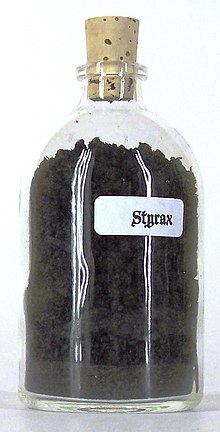Styrax (incense)
The Storaxharz , often only as Styrax , liquid Amber or balsam called, is a fragrant natural resin , which is used for Räucherwerke or as a remedy. Even in ancient times , the resin was one of the most important and sought-after incense, which was used in a variety of ways (Pliny, Naturalis historia 12; 81,124, Dioscurides , Materia Medica I, 79). The Phoenicians brought the Styrax to Egypt , they called it "miniaki" ( Ebers papyrus ).
origin
Until the 18th century it is said to have been obtained exclusively from the Storax tree ( Styrax officinalis ) from Asia Minor and the eastern Mediterranean region, but this is controversial, even questionable. According to this, the majority of the storax resin comes from different types of the sweet gum trees, which are very similar in smell but not closely related to the storax trees ( Liquidambar orientalis , from North America Liquidambar styraciflua , from East Asia Liquidambar formosana ), which are therefore sometimes referred to as storax trees. Accordingly, depending on the origin, the incense is referred to as real Styrax (resin from Styrax officinalis ) and false Styrax (resin from Liquidambar species). There are also substitutes of Altingia excelsa (Burmese Storax) and Altingia gracilipes .
Storax resin, also referred to as "Styrax" in German, is to be differentiated from benzoin which comes from other Storax trees ( Styrax ).
Extraction
It is obtained in a similar way to frankincense : the trunk is cut and the resinous mixture that emerges is collected. Since this raw material has a high proportion of liquid, it must then be refined. This is done either by air drying or by distillation . In the past only steam distillation was used, which also gives the best quality. Nowadays, an alcohol is often used, sometimes only as an intermediate , as this increases the yield.
properties
In addition to many other ingredients, Styrax mainly consists of cinnamic acid , styracine , cinnamic acid ethyl ester , vanillin , cinnamein , storesinol and a small amount of styrene .
The Styrax smoke smells slightly sweet and has a relaxing and calming effect.
use
The balsam has been used for smoking since ancient times and today, alongside frankincense, it is the most important incense of the Greek Orthodox Church . In most cases, charcoal is soaked in Styrax balm and this is then burned on charcoal or charcoal .
In medieval medicine, storax was part of the drug repertoire. As described in Circa instans , it was replaced or falsified by oris root in the sense of a fake drug .
The folk medicine uses the Styrax with bronchitis , heart disease, leprosy , stroke and constipation. Externally, it is used for scabies and as a wound healing agent. In perfumery it is valued in many classic fragrance compositions for its balsamic-sweet, slightly grass-like scent and added as a fixative .
literature
- Karl Dieterich, Erich Stock: Analysis of the resins. 2nd edition, Springer, 1930, ISBN 978-3-642-89462-6 , pp. 348-366.
Individual evidence
- ↑ Günther Ohloff : Earthly Scents - Heavenly Lust: Springer, 1992, ISBN 978-3-0348-6161-8 , p. 61.
- ↑ Does Styrax officinalis L. provide a resin? (PDF; 2.87 MB), from e-periodica.ch, accessed on January 1, 2017.
- ^ Paul T. Nicholson, Ian Shaw: Ancient Egyptian Materials and Technology. Cambridge University Press, 2000, ISBN 0-521-45257-0 , p. 437.
- ↑ Jehuda Feliks: Storax. In: Fred Skolnik, Michael Berenbaum: Encyclopaedia Judaica , Vol. 19, 2nd Edition, 2007, Thomson Gale, ISBN 978-0-02-865928-2 , p. 238, online .
- ^ Albert Weinlig : Die Pflanzenchemie, a handbook for doctors and pharmacists. Wilh. Vogel & Sohn, Leipzig 1839, p. 519, ISBN 978-5-87854-779-6 (Let Me Print, 2012, reprint).
- ↑ Scherrer , Virchow , Eisenmann : Canstatt's annual report on the progress of the entire medicine in all countries . 5th volume, Stahelsche Buchhandlung, Würzburg 1858, p. 15 ff.
- ^ Jean H. Langenheim: Plant Resins. Timber Press, 2003, ISBN 978-0-88192-574-6 , p. 350. online (PDF; 22.18 MB).
- ↑ Konrad Goehl : Observations and additions to the 'Circa instans'. In: Medical historical messages. Journal for the history of science and specialist prose research. Volume 34, 2015 (2016), pp. 69-77, here: p. 70.
